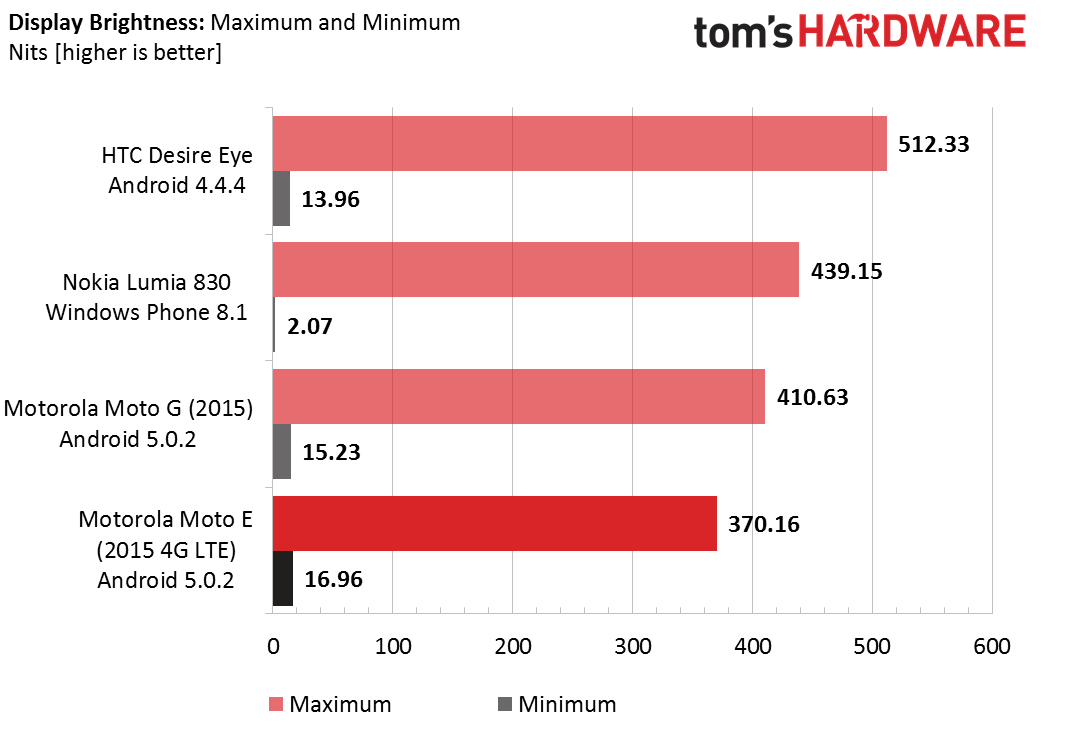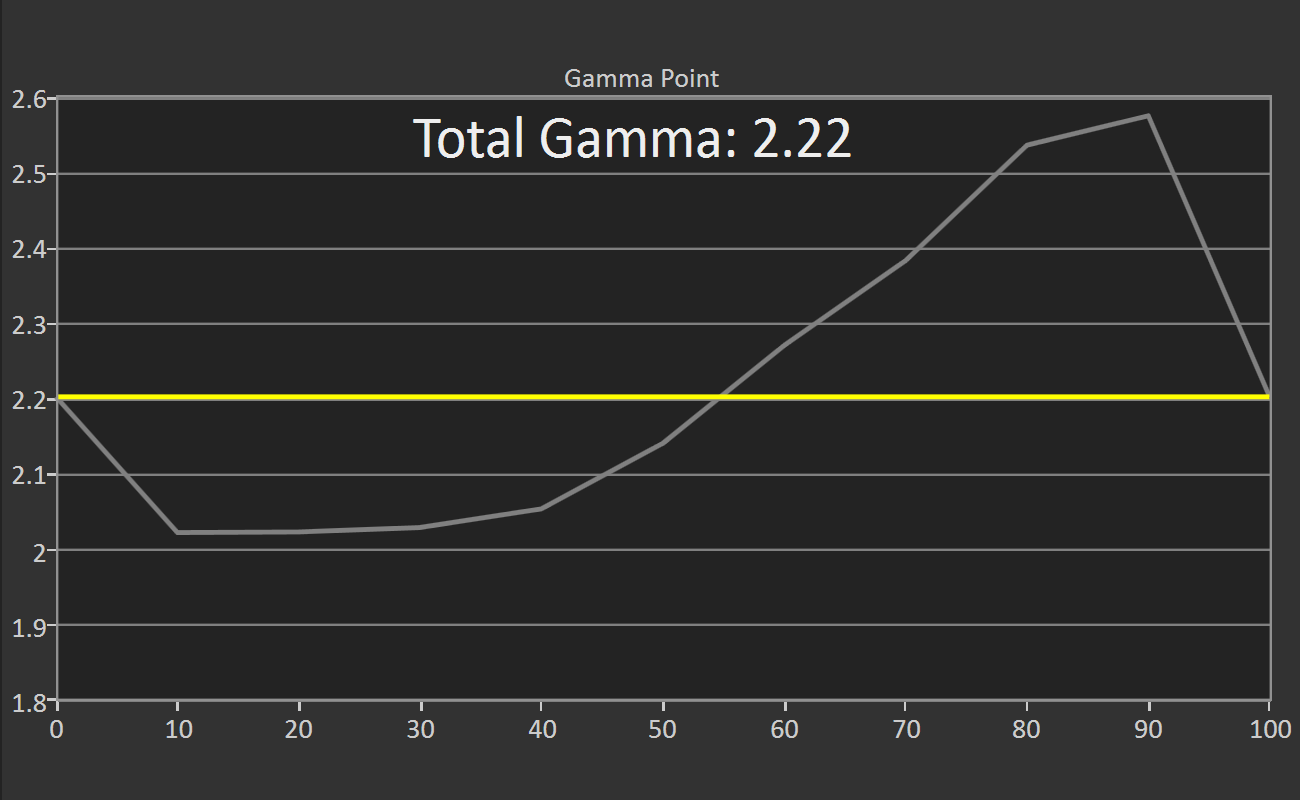Motorola Moto E (2nd Gen) Review
Motorola’s second generation Moto E receives significant enhancements, including a faster 64-bit SoC, front-facing camera, and bigger battery. There’s even an LTE option. Is this budget smartphone worth more than its bargain price?
Why you can trust Tom's Hardware
Display And Audio Performance
The Moto E (2nd gen) comes with a 4.5-inch IPS LCD screen that is slightly larger than the original Moto E’s screen; however, it retains the same qHD 960x540 resolution, giving it a pixel density of 245 PPI. While not high enough to qualify as a retina display, text is reasonably clear but pixels are still noticeable, giving the screen a slight grainy appearance.
Thanks to continuous advancements in display technology, displays for even low-end smartphones have become quite good. The new Moto E’s display has good viewing angles, with some shift in brightness but not color.
One thing that betrays the phone’s budget provenance is the rigidity of the screen, which, despite using Corning Gorilla Glass 3, bends when you press on it rather than feeling like hard glass as most smartphone screens do these days. This is reminiscent of the old days of resistive-type screens which actually needed some amount of pressure to work.
There’s also significantly higher friction when swiping on the screen compared to other devices, which can make some touch usage, such as scrolling, slower and less enjoyable.
We’re using SpectraCal's CalMAN software and SpectraCal C6 colorimeter for display measurements. All of the charts below with a gray background were generated in CalMAN v5 Ultimate.



The new Moto E gets reasonably bright, but falls shy of the 400 nit milestone and the Moto G (2nd gen). This makes the screen a little hard to see in direct sunlight. It does have a respectable black level, similar to the Moto G, giving it a decent contrast ratio that’s better than the higher priced Nokia Lumia 830.


The Moto E’s average gamma level of 2.22 comes very close to the ideal of 2.2, easily surpassing the Moto G and the more expensive Lumia 830 and HTC Desire Eye. However, gamma begins to rise at the 50% grayscale mark, eventually spiking to nearly 2.6 at 90% grayscale, leading to darker shadows and a loss of highlights.
Get Tom's Hardware's best news and in-depth reviews, straight to your inbox.


Most mobile displays tend to show colors on the cool side of the color temperature spectrum and the Moto E is no exception. With an average color temperature just under 7,000K, and values even closer to the ideal as we move up the grayscale graph towards white, the Moto E avoids the blue tint that plagues other displays.
Checking the RGB balance confirms what we saw in the color temperature graph above. Most gray levels have slightly more blue content, with a bit more green at 100% (white). Still, these are good results, avoiding any noticeable color tinting except at the 100% white level.


Average grayscale ΔE2000 falls just above three, a value that’s noticeable but considered acceptable. It’s similar to Motorola’s Nexus 6 (3.02) and better than both the Moto G and LG G3 (4.02).
Grayscale error hovers around two over a wide range of grayscale values, but spikes near 100% white. This is because the Moto E’s display shifts towards green at this end of the spectrum.


The Moto E display does a good job covering the sRGB color space. Without an operating system or apps that support color management, there’s no need to support a wider gamut.
In the color saturation sweep, we see that red and blue seem to be somewhat undersaturated. In other words, the measured color falls short of each 20% box. We also see that the Moto E misses the blue corner of the sRGB triangle, unable to represent a true 100% blue.


In the color accuracy test, the Moto E does very well with an average error below three and a maximum error of 5.89 for white. This shows that the Moto E’s display was color calibrated and has a high degree of color accuracy, better than the Moto G and sitting between the Samsung Galaxy Note 4 (2.23) and the LG G3 (3.05).
The color palette above shows the target color on the bottom and the color displayed by the Moto E on top. We can see a slight green tint on the white swatch, as suggested in the grayscale tests. The Moto E’s 100% blue is also a bit light like we saw in the color saturation sweep. For most of the colors, however, the actual color and the target color are very close to each other.
For a lower-cost phone, the display in the Moto E (2nd gen) is actually very nice. We were surprised by how well calibrated the display is, easily beating the color accuracy of more expensive devices, including Motorola’s own Moto G (2nd gen) and Nexus 6. Our only complaints are that max brightness falls short of 400 nits and whites display with a slight greenish tint.
Audio Performance
For the new Moto E, Motorola decided to remove the bottom-front speaker, either because the company did not want to pay double for the speakers or it was a design choice meant to streamline the device and make it slightly more compact. This does not seem to make a major impact on the loudness nor the clarity of the speaker compared to the Moto G which comes with two.
The external speaker on the Moto E (2nd gen) keeps distortion to a minimum at max volume. At normal listening levels, it’s still possible to hear individual notes and instruments when listening to heavy metal, but sounds start blending together with multi-layered electronic music, making it sound a bit garbled. Folk music, or music centered on vocals, plays to its strengths.
Bass notes, of course, are soft. With the EQ turned off, the midrange is strong, which is important for vocals or just listening to someone on a phone call, but trails off at higher frequencies. The “Brilliant” EQ setting sounds too tinny, but “Bass punch” helps shore up both the low and high ends a bit, and is probably the best setting.
Plugging in a set of good headphones provides a similar listening experience. Relative to the iPhone 6, bass has less punch and the Moto E lacks clarity; the signal-to-noise ratio seems lower.
Just like with the external speaker, vocals start blending together with instruments when listening to multi-layered electronic music. With the EQ turned off, the output sounds flat and lifeless. There’s no power behind the vocals and it’s just not really fun to listen to. Activating the “Home theater” EQ setting livens the sound up a bit, but the low-end has too much emphasis and sounds too rumbly. The “Live stage” EQ setting seems to be the best compromise, shoring up the bass and midrange without the rumbling heard with “Home theater.”
Overall, the sound is not bad for a phone in this price range. It’s certainly not fair to expect the same level of audio performance as an iPhone, Sony Z3, or Nexus 6. With some EQ help, the Moto E (2nd gen) provides an acceptable listening experience for casual use, but will not thrill music buffs.
Update [09:02 6/17/2015]: Fixed signal-to-noise ratio reference.
Current page: Display And Audio Performance
Prev Page Moto E (2nd Gen) Hardware Design Next Page Camera Hardware And SoftwareLucian Armasu is a Contributing Writer for Tom's Hardware US. He covers software news and the issues surrounding privacy and security.
-
emad_ramlawi Lenovo k30-W for the winReply
all the above +
HD ready resolution 720p
internal storage 16GB
the only con, is there OS, which is good, but not really vanilla android -
atljsf i bought one and had to return it, it restarts while charging and motorola at this moment hasn't solved the problem, a shame because it is a nice fast phoneReply -
tekelymailcom The only international variant mentioned is the XT1505 but there are more. I found very interesting the XT1523 which has 16GB, dual sim and digital TV reciever.Reply -
HideOut There might be an error in the speaker/sound part above. "Plugging in a set of good headphones provides a similar listening experience. Relative to the iPhone 6, bass has less punch and the Moto E lacks clarity; the signal-to-noise ratio seems higher." The S/N ratio on the Moto E should be LOWER, not higher if it sounds like its lacking clarity.Reply -
HideOut There might be an error in the speaker/sound part above. "Plugging in a set of good headphones provides a similar listening experience. Relative to the iPhone 6, bass has less punch and the Moto E lacks clarity; the signal-to-noise ratio seems higher." The S/N ratio on the Moto E should be LOWER, not higher if it sounds like its lacking clarity.Reply -
MobileEditor ReplyThe S/N ratio on the Moto E should be LOWER, not higher if it sounds like its lacking clarity.
Good point. I must have been thinking of THD, which is expressed as a percent. I've made the necessary correction.
- Matt Humrick, Mobile Editor, Tom's Hardware -
Dr3amCast I also purchased this phone and experience the restart while charging issue. Also, the performance is on par with a very, very basic Lumia 510 I had the misfortunate of having to use for a short time. The phone chugs while multi-tasking. And I mean by just hitting the home screen instead of closing out of apps. And even that takes an inordinate amount of time. I'm talking a noticeable 3-4 seconds after you hit home: your background wallpaper shows up, but no icons or app try icon, then another second or 2 later the icons show up. It's performance is dreadful. As well is its 1GB of memory. If I'm in the car I use bluetooth and Google Play Music / Google Maps. If I begin navigating to a destination and begin playing music Maps will close. I'm assuming due to lack of sufficient RAM. If I'm at a stop light and open snapchat, Google Play Music, Maps or Waze will close if I view a Snap. It's really rather frustrating the more you use the device. And I don't have many apps on here at all. Essentially just FB, Twitter, Snapchat, Waze, WatchESPN, HBOGo. That's all. It's frustrating seeing reviews like these on this phone that don't actually put it through its paces for a decent amount of time.Reply -
MobileEditor ReplyI also purchased this phone and experience the restart while charging issue. Also, the performance is on par with a very, very basic Lumia 510 I had the misfortunate of having to use for a short time. The phone chugs while multi-tasking.
I'm sorry you had a poor experience, but thanks for taking the time to add your story. This is why we included the HTC Desire Eye in our performance evaluation, so our readers could see the performance delta between some lower-cost devices and last year's flagships running Snapdragon 801 SoCs, which are now considered mid-tier.
Our unit did not experience the restart while charging issue, and while this comes as no solace to you, the Moto E handled its 1GB of RAM better than the Lumia 830 did during our testing and evaluation.
- Matt Humrick, Mobile Editor, Tom's Hardware -
quadrider21 I've experianced BT connectivity problems with both the Moto G and this new Moto E when connected to various cars. I'd be wary purchasing these phones if you rely on BT connectivity in your cars.Reply




